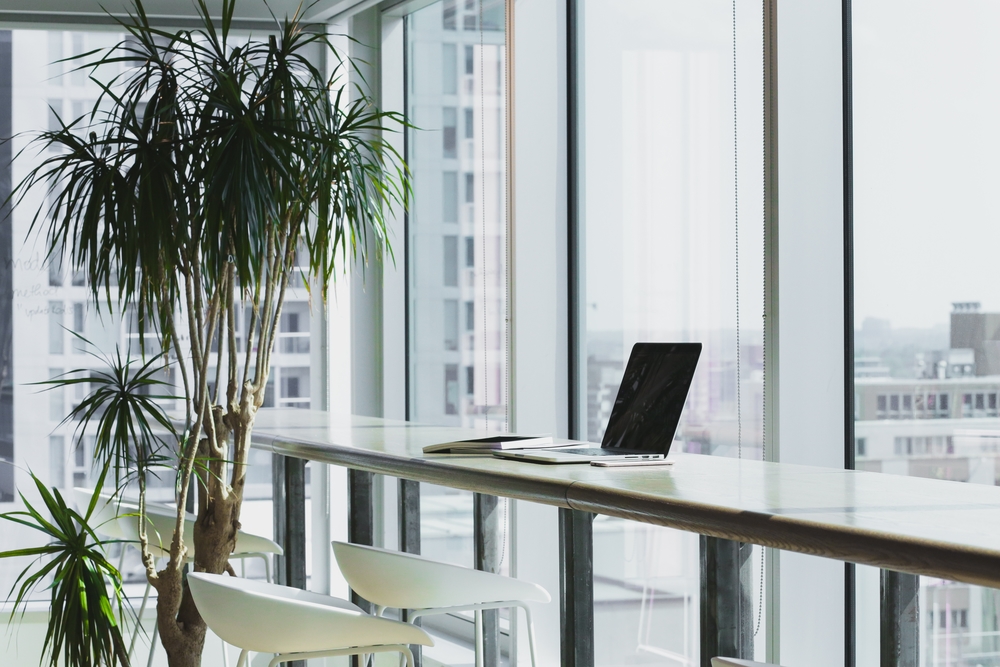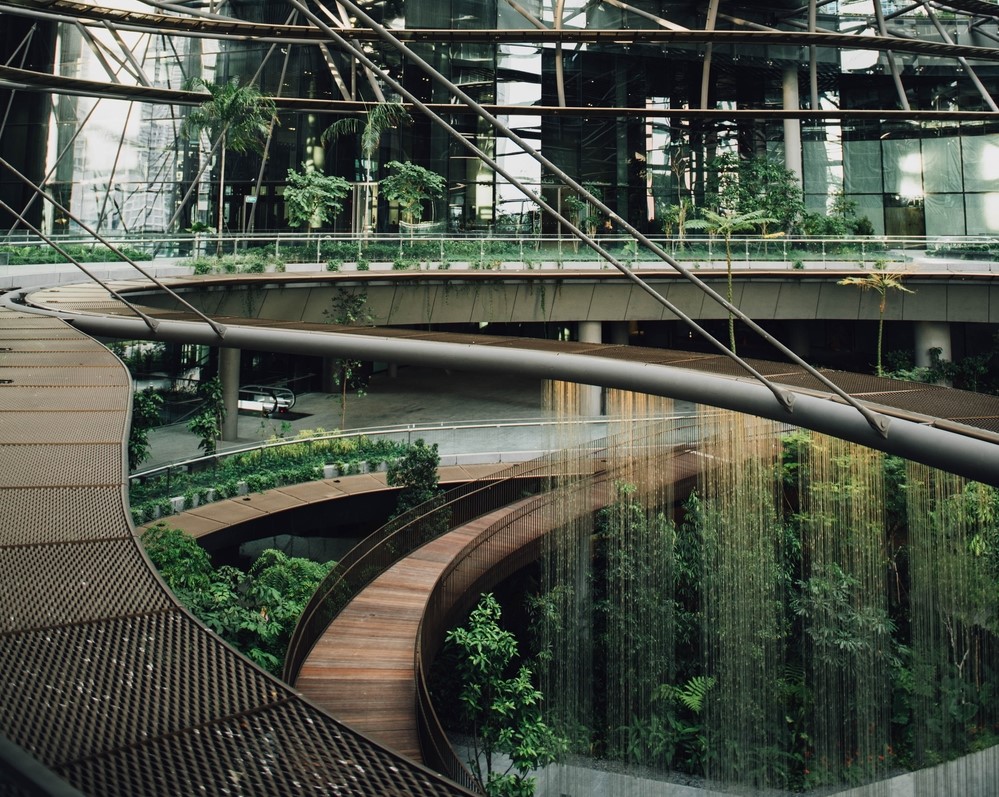Over the last decade, one of the most exciting developments in office interior design has been incorporating greenery into the workplace. Bringing the outdoors indoors has revitalised the once-drab spaces in which employees were once confined. It’s even been proven to boost staff performance, well-being and happiness.
So, what is it about incorporating nature into our work environment that has such a positive impact?
Office design specialists Diamond Interiors look at the science to explain how you can go beyond the odd desk plant and transform any office environment, whether it’s through a full office refurbishment or a mid-year rejig.
The biophilia hypothesis
The nature-inspired office might seem like a recent trend, but it actually been around for a long time.
It started with the work of American psychoanalyst Erich Fromm in 1973. He coined the term ‘biophilia’ to describe what he thought to be an innate love of nature in all human beings. Biophilia manifests in the way we interact with spaces: what we pay attention to, what we withdraw from, and where we feel safe.
Twenty years later, biologist Edward O. Wilson applied this concept to indoor layouts. He used ‘biophilic design’ to define artificial spaces that mimic the environments we find in nature. In collaboration with author Stephen Kellert, Wilson identified the benefits of biophilic design were recognised in the world of architecture The Biophilia Hypothesis (2008).
Since then, biophilic design has germinated and bloomed into a positive trend that some of the world’s biggest companies have embraced, including Google, Microsoft and Amazon.
How to incorporate biophilic design into the workplace
Biophilic design is about so much more than the odd fern here or there. It’s about creating an environment that mixes a variety of elements from nature to invigorate the senses; it should be a key part of your office planning.
There are three bases that you should cover when designing a biophilic office space: the visible, the material, and the sensory.
1. The visible
Humans rely on sight as the dominant sense. That makes us pretty unique. Think about visibility first when planning out your space — it’ll make such a difference in the long run.
Natural and dynamic lighting

Natural light does two important things, beyond brightening up a room and making it feel more alive.
Firstly, it reduces the contrast between the dim artificial lighting and the harsh blue light emanating from computer screens, reducing headaches and feelings of fatigue.
Secondly, the intensity of natural light changes throughout the day as the sun moves. This helps with your circadian rhythm, meaning you feel fresher in the morning and get better sleep at night.
Practical ways to get natural light into an office space
- Windows and skylights — Are you making the most of the windows in your space? Simple tricks like building desks and features around your window layout South-facing windows will get the most of the sunlight throughout the day.
- Dynamic and UV lighting — Sunlamps and UV lights are a fantastic way to inject natural light into spaces where there isn’t any present. If you want to go a step further, you can even get dynamic lighting that mimics the movement of the sun throughout the day, helping you get back to that natural rhythm that’s so often disrupted in the bustle of modern life.
Colours
In terms of colour schemes, this largely involves earthy tones, such as greens, browns, golds, and tans, as well as blues and white to mimic the sea, sky, and clouds.
Incorporating green accents in offices have been found to boost employees’ motivation and productivity as well as their sense of well-being. Humans are attuned to seek out colours used in nature, so pick accents that mimic fruits and flowers, too: violet, fuschia, amber and papaya are all fantastic options to be used in small doses.
A distant view
One of the patterns of biophilic design identified by Terrapin Bright Green in their report 14 Patterns of Biophilic Design is that humans feel safer when they are at a vantage point to survey objects in the distance. It goes back to our prehistorical days on the savannah and helps account for why people might pay more for a room if it has a great view of the sea.
That feeling of security is particularly helpful for workers; it reduces anxiety and helps them focus.
Practical ways to provide a scenic view
- Open the curtains — A simple trick, but keeping the windows open during the day keeps a view in their peripheral vision.
- Mezzanine — If you have a large office space, you could consider building a mezzanine area. This helps fulfil the inner ‘surveillance’ instinct enough if the view outside is limited.
- Paintings and photographs — No, it’s not cheating. Paintings and photographs of landscapes can have a positive effect on mental wellbeing, particularly if they’re large prints. Put them on the walls in areas where window access might be limited.
2. The material
Plant life
Plants and flowers are an important part of biophilic design. Stephen R. Kellert writes in Metropolis magazine that “biophilic design focuses on those aspects of the natural world that have contributed to human health and productivity in the age-old struggle to be fit and survive.”
Plants are perhaps the most life-giving of the natural elements available to us, which means they have a central role in bringing the outdoors indoors.

Practical ways to incorporate plant life in a built-up environment
- Potted plants — A very simple fix but effective nonetheless. Living potted plants oxygenate the air, keeping workers more awake, alert and engaged. Plus, those vibrant greens and luscious pinks bring plenty of life to your office’s palette without breaking the bank. Make sure you get a variety of species to mimic a diverse, thriving ecosystem.
- Plant walls — As practical as they are artful, plant walls are a creative space-saving trend in biophilic design. These living walls change and evolve with the seasons, creating an immersive feeling as being outdoors even when you’re not.
Patterns and textures
It’s not just colours and objects that create a more natural feel in a space. Patterns and textures that mimic those found outside — known as ‘biomorphic forms’ — are just as important.
A great way to introduce those textures into office space is with natural furnishings like wood, stone and marble help emphasise a room’s natural design.
Practical ways of incorporating natural materials into office design
- Worktops — Vary the types of desks and tables that you use in your office. Different types of wood, minerals and even things like concrete can help your staff escape the artificial feel of melamine and PVC. Unique, natural textures are a great way to create a more tactile space that staff will want to interact with.
- Walls and ceilings — A light-wood ceiling is a great way to bring a natural feeling to your space without intruding. You should also consider multi-material walls that vary in texture, too.
Furniture
The best way to incorporate biophilic design into your furniture choices is to look for obscure and unusual shapes combined with naturally-occurring materials. The result is visually striking and distinctive, filled with those little quirks that people come to identify and love.
Ideas for biophilic furniture
- Chairs — Go for tactile materials like rattan, wicker and teak when thinking about the kind of chairs you want. Incorporate a range of back heights and styles and place them together for intimate diversity. Pair them with woven cushions and throws with earthy tones to soften it up.
- Break-out spaces — Mix things up with a variety of furniture for your break-out spaces. Bean bags are actually a great option; since they change shape whenever someone sits in them, they regularly change the way an indoor area looks. Plus, they’re really comfortable!
3. The sensory
Sound
What we hear is so important. Silence makes us overly alert to our surroundings, while too much noise leaves us overloaded with information.
But sound does so much more than that. Done correctly, it can be energising or even calming, helping you focus and feel at peace.
Ideas to use sound in biophilic design
- Water features — The sound of running water has a calming effect on the human mind. Bring that serenity into an office building with carefully placed water features. Use natural materials like slate and bamboo to elicit that feeling of being next to a waterfall or in a rainforest.
- Rooms within rooms — Try separating areas using naturally sound-absorbant materials like cork or straw. A living wall can function as a vibrant sound barrier between two environments within one bigger space, which helps you limit the volume without isolating anyone. It also makes a great visual feature to break up your space and make it feel distinctive.
Spatial diversity

The natural world isn’t arranged into predictable blocks. Spaces vary thanks to complex geographical patterns. You should try to replicate that natural variety when you plan your space.
By creating a varied environment, you give employees freedom of choice; if they want to collaborate, they can choose an open space, whereas if they want to focus, they might prefer something more enclosed.
Practical ways to vary your space
- Different ceiling heights — Areas with a lower ceiling have different acoustic properties that those with more space, making them generally quieter and more private. It might be that you use the biomorphic materials mentioned earlier to create features, so the ceiling height changes around the office.
- Areas to withdraw — Everyone needs a little personal space from time to time. Create focus areas for employees to withdraw to if they need to. They should be small, fitted with sound-limiting materials, and have restricted visibility from others. Instead of putting people in a ‘glass bowl’-type room — which makes them feel watched — try a snug, intimate space built with two-toned walls and dark materials like walnut and exposed brick.
Bring the outdoors indoors
Thanks to its many benefits and increasing demand from business owners who want the very best for their workforce, biophilic design doesn’t look like it’s going anywhere soon. With the above tips, you can begin planning out a workspace that’s as good for your body as it is for your mind.
Looking for more ways to make your office go green? Why not check out our blog on how you can design an eco-friendly office. If you have any other questions, don’t hesitate to get in touch with our team.
Sources:
https://medium.com/@SmartVisionLabs/why-vision-is-the-most-important-sense-organ-60a2cec1c164#
https://www.smithsonianmag.com/smart-news/led-skylights-perfectly-mimic-natural-sunlight-180954348/
https://www.terrapinbrightgreen.com/report/14-patterns/
https://www.metropolismag.com/architecture/what-is-and-is-not-biophilic-design/
https://www.ambius.com/green-walls/ultimate-guide-to-living-green-walls/
http://www.bbc.com/capital/story/20160617-the-never-ending-battle-over-the-best-office-temperature
